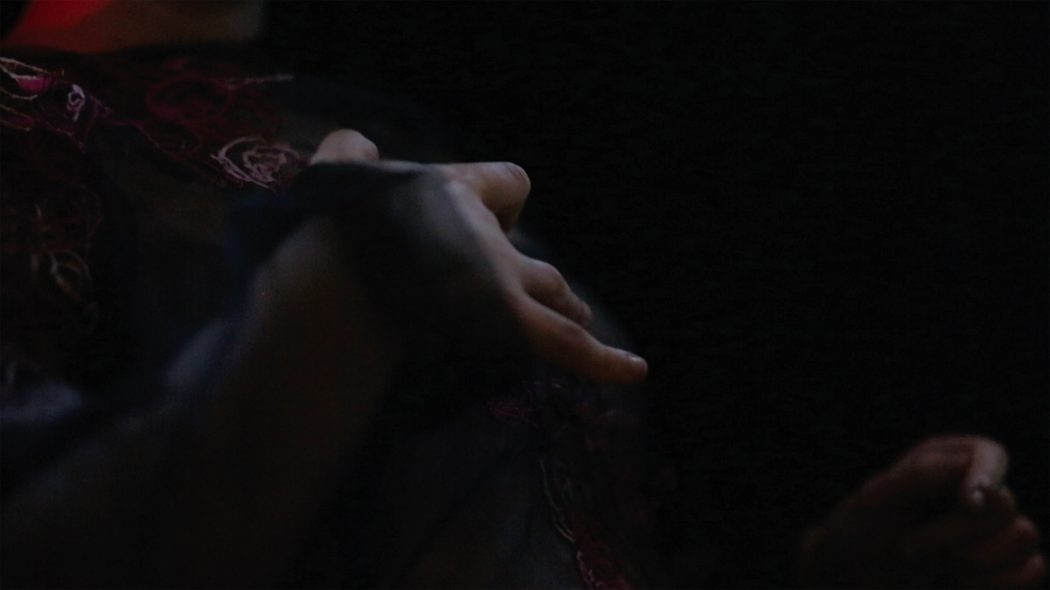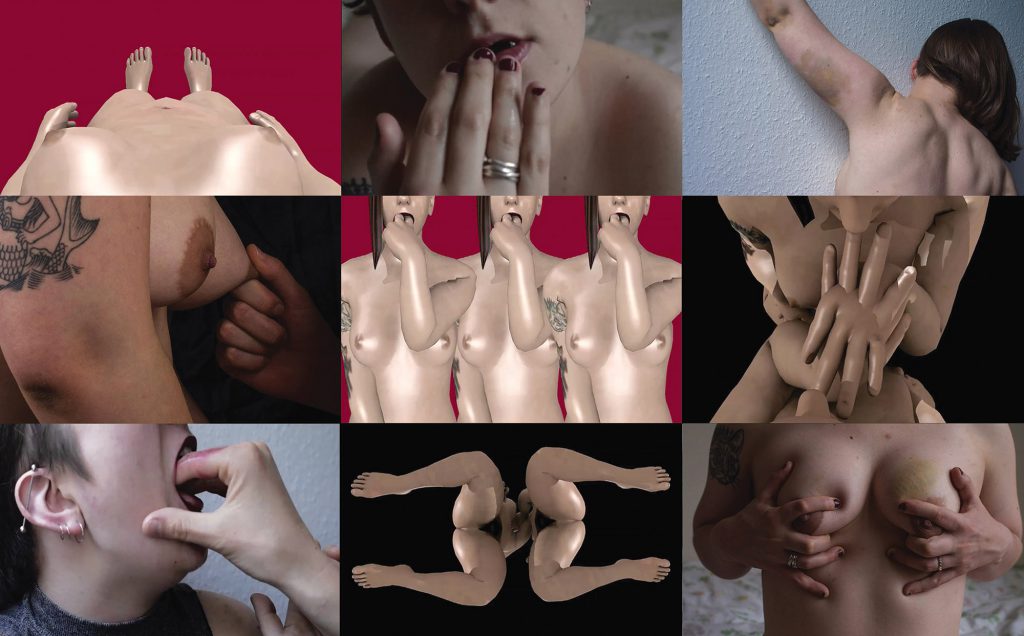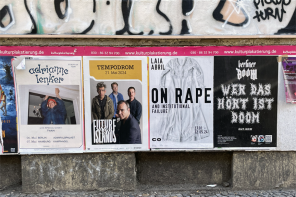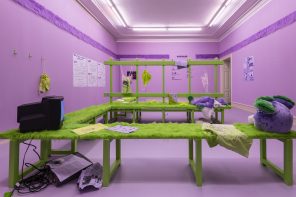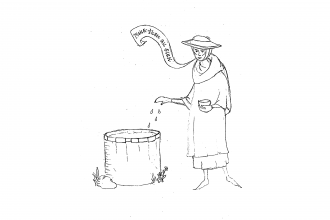It started uncertainly:
“Hi”
“Hi…”
“Are you ready?”
“I think so”
“..so you can touch me, or I can touch myself. Which would you prefer?”
And then, “You touch yourself” or, “I can touch you?”, or sometimes “Oh wow”, or even “Neither”, followed by leaving.
One participant asked me to touch her instead, stopping us both in our tracks. “That… won’t work, because you aren’t wearing the controller.” I said, after a beat. “OH, I get it!”, she said, and we carried on as usual.
People described feeling awkward. One person cried. Reactions varied. Most often, I heard, “this is really intense”.
Assembling Desire was composed of nine screens, four with sound and five without. The screens were small, requiring the user to get close to see their output. To change the images on the screens, someone (me or the participant) needed to make contact with the sensor, made up of thin gauge wire embedded in the embroidery on the black chiffon suit I was wearing. The embroidery, in shades of pink, purple, red, and brown, depicts a variety of hands and flowers, textured and soft, with the copper wire running through the design. Touching different parts of the suit activated images, videos, animations, and sounds, and what the participant experienced hinged on how much and which parts of the suit I let them touch.
Assembling Desire was a work outside my comfort zone from the start. How would I communicate a complex concept through a sensor-based input/output system, without being visually literal or making something that caves to a preconceived notion of what ‘technology’ looks like? How would I perform a piece that navigates physical contact with strangers when being touched, especially by men, often makes my skin crawl beyond my control? How would I balance the desire and necessity of communicating an evocative experience without overwhelming the participant and their ability to participate? And, most importantly, how would I make a piece about queer femme sexuality and sexual desire for femmes, without setting up a traditional subject-object relationship with the people I desire? So often visual pieces about sexuality begin and end with portraits of one’s lovers, but that felt like hiding the depth of my desire, of how personal it is to me, and how it exists within me when not directed outward. Assembling Desire made my desire tangible in a world outside of myself, a world that doesn’t have context for it.
I’ve been working up to talking about my sexuality directly in my work. Our culture centers masculinity, and women and femmes are encouraged to relate to each other around men and masculinity. I’d noticed, starting as a teenager, that not participating in this dynamic made me un-relatable to other women, as did refusing to perform stereotyped, oppositional masculinity to indicate sexual interest in femmes. We still don’t have a lot of words to describe attraction and sexuality that aren’t mired in a heteronormative system, and it’s a struggle to not be reduced to a fetish by language itself, let alone by participants and the public. My biggest fear in Assembling Desire was of reprising my teenage sense, not of invisibility or erasure, but of pure irrelevance, except as a fetish or a predatory force. Creating this work meant being vulnerable to the feeling of being an alien out of context, sometimes still ashamed of that heart flutter of recognition when I see femme/femme (or femme-adjacent) lovers or couples.
Examining my desire, in preparation and during the performance, was fun in that I got to explore the things I enjoy, visually and viscerally, and spend time considering how to integrate them. With participants, I used a script that was a guided approximation of verbalized consent in a sexual interaction, adapted to allow me some control, while still allowing the participant to state their boundaries. During the interaction, I checked in with the participant, asking if it was okay for them and how they were doing. They tended to mirror these questions back to me, asking if I was enjoying our interaction. It felt important for me to be able to communicate verbally, but most people treaded lightly on my boundaries. I had to coax many participants to use enough of their hand to activate the sensor, while others insisted on grabbing and poking at me, ignoring my instructions to stroke me. One man left, muttering that he “has a girlfriend”. I also rejected one overtly sensual touch, and the man giving it demanded to know why “that’s all I [he] got”. Another interrupted me to insist I explain how the piece works technically, threatening to refuse to believe I made it myself if I didn’t. I didn’t, and he left, too. I thanked everyone who participated.
I have seen and participated in performance-based work involving touch before, but not in an academic context. This presented certain challenges in itself, since academic environments can be not only unsympathetic but sometimes overtly threatening to queer bodies and lived experience. I absolutely did not want anyone to feel pressured to participate, or to do so in a way that did not work for them. The necessity of a content warning, which I would have attached anyway in some format, became a requirement. With all of these overlapping concerns, considerations, and questions, Assembling Desire could have instead assembled a new level of anxiety. Instead, I pushed myself into vulnerability about my desires, and found that vulnerability, though sometimes rejected, was more often matched by participants. All of the factors that complicated the creation of this piece still exist, but even within that, feeling myself as both exposed and intentionally seen, as a creator and a being and a lover, was powerful. Connection is profound and vital, and it is what a heteronormative world denies us. In being vulnerable and inspiring vulnerability, I created space for others to experience connection and identify themselves.
Words and images by Kiona H. Niehaus

